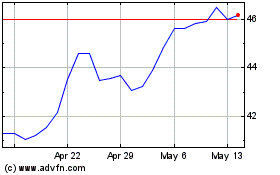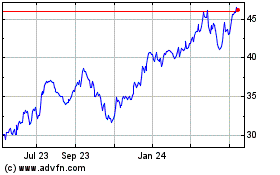U.S. Oil Exports Rising Amid Middle Eastern Turmoil
June 24 2019 - 3:58PM
Dow Jones News
By Ryan Dezember
U.S. crude exports are surging, reflecting strife along the
Strait of Hormuz that has given oil buyers second thoughts about
the Persian Gulf.
The hostilities, including attacks on oil tankers passing
through the important supply route, have lifted crude prices, sent
tanker rates surging and opened a window for U.S. producers to sell
more barrels abroad, taking market share from the Organization of
the Petroleum Exporting Countries in the process.
RBC Capital Markets forecasts that 21 very large crude carriers,
or VLCCs, will be loaded this month along the U.S. Gulf Coast, well
above the monthly average this year of 13 ships and the record of
17 reached in March.
The average day rate for modern VLCCs, used to ship crude and
petroleum products, has risen 69% to $30,759 since tensions flared
in the strait earlier this month, according to Jefferies Financial
Group Inc.
West Texas Intermediate futures for August deliver gained 0.8%
to $57.90 a barrel Monday on the New York Mercantile Exchange, a
three-week high. Brent crude, the global benchmark, declined 0.5%
to $64.86 a barrel on London's ICE Futures exchange.
The $6.96 difference between the two prices is the slimmest it
has been since April.
The spread is even narrower between Brent and a widely cited
price set in Houston, though at a few dollars it remains enough to
entice buyers to make the trip to U.S. waters, said RBC analyst
Michael Tran.
"If you don't have to buy a barrel that comes through the Strait
of Hormuz you're certainly inclined to do so," Mr. Tran said.
"Security of supply is a huge topic."
President Trump weighed in on Monday, calling for countries that
are dependent on Middle Eastern oil to ensure safe passage of their
own vessels. He specified China and Japan.
"All of these countries should be protecting their own ships on
what has always been...a dangerous journey," the president wrote on
Twitter on Monday morning. "We don't even need to be there in that
the U.S. has just become (by far) the largest producer of Energy
anywhere in the world!"
Mr. Trump's administration has blamed Iran for the tanker
attacks. Iran has denied involvement but the country's
Revolutionary Guard has claimed responsibility for shooting down a
U.S. drone last week. That claim came hours after a Saudi
desalination plant was struck by a missile that appeared to come
from Yemen.
Mr. Trump declined to launch retaliatory attacks on Iran and
instead has said his administration will tighten economic sanctions
on the country, which have been aimed at choking off Iranian oil
exports. Iran, meanwhile, has threatened to shut down the strait if
sanctions aren't lifted.
The equivalent of 21% of the petroleum liquids consumed globally
in 2018 passed through the strait, according to the U.S. Energy
Information Administration. Increasingly, those ships are bound
somewhere besides the U.S., which has been producing crude in
record volume and gaining global market share as sanctions take
barrels from Venezuela and Iran off the market.
EIA data released last week showed U.S. crude exports on the
rise, pushing to 3.4 million barrels a day during the week ended
June 14. The record, set in mid February, is 3.6 million barrels a
day. At the same time, imports from OPEC members are at a 30-year
low.
Those factors, along with a weakening dollar and strong demand
from U.S. drivers, have traders reversing what had been a bearish
outlook on oil prices heading into a summit between OPEC and its
allies, which is expected to take place later this month in
Vienna.
"Oil traders will be hard pressed to push short bets in light of
the possibility of meaningful Persian Gulf supply disruptions,
unless they truly see tensions moderate significantly," said Pearce
Hammond, an analyst with Simmons Energy.
Write to Ryan Dezember at ryan.dezember@wsj.com
(END) Dow Jones Newswires
June 24, 2019 15:43 ET (19:43 GMT)
Copyright (c) 2019 Dow Jones & Company, Inc.
Jefferies Financial (NYSE:JEF)
Historical Stock Chart
From Mar 2024 to Apr 2024

Jefferies Financial (NYSE:JEF)
Historical Stock Chart
From Apr 2023 to Apr 2024
